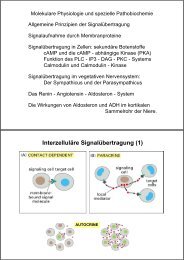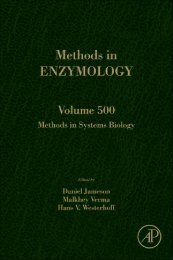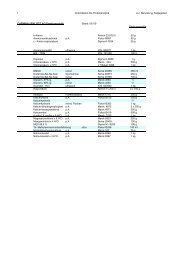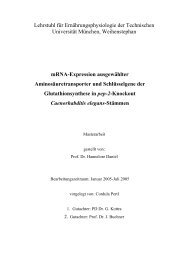Review The role of insulin and IGF-1 signaling in longevity
Review The role of insulin and IGF-1 signaling in longevity
Review The role of insulin and IGF-1 signaling in longevity
You also want an ePaper? Increase the reach of your titles
YUMPU automatically turns print PDFs into web optimized ePapers that Google loves.
CMLS, Cell. Mol. Life Sci. Vol. 62, 2005 <strong>Review</strong> Article 327<br />
known to extend yeast lifespan, <strong>in</strong>clud<strong>in</strong>g am<strong>in</strong>o acid restriction,<br />
salt stress <strong>and</strong> heat stress [168]. All these results<br />
show a strong connection between ma<strong>in</strong>tenance <strong>of</strong> chromat<strong>in</strong><br />
structure/silenc<strong>in</strong>g, metabolism <strong>and</strong> <strong>longevity</strong> <strong>in</strong><br />
yeast.<br />
In mammals, it has been shown recently that SIRT1 activates<br />
a critical component <strong>of</strong> calorie restriction: fat mobilization<br />
<strong>in</strong> white adipocytes [169]. Upon food withdrawal<br />
SIRT1 prote<strong>in</strong> b<strong>in</strong>ds to <strong>and</strong> represses genes controlled by<br />
the fat regulator PPAR-g (peroxisome proliferator-activated<br />
receptor-g), <strong>in</strong>clud<strong>in</strong>g genes that mediate fat storage,<br />
by dock<strong>in</strong>g with its c<strong>of</strong>actors NCoR (nuclear receptor<br />
co-repressor) <strong>and</strong> SMRT (silenc<strong>in</strong>g mediator <strong>of</strong> ret<strong>in</strong>oid<br />
<strong>and</strong> thyroid hormone receptors). Mobilization <strong>of</strong> fatty<br />
acids from white adipocytes upon fast<strong>in</strong>g is compromised<br />
<strong>in</strong> Sirt1 +/– mice [169].<br />
In addition, overexpression <strong>of</strong> SIRT1 <strong>in</strong> 3T3-L1 adipocytes<br />
attenutates adipogenesis, while RNA <strong>in</strong>terference<br />
<strong>of</strong> SIRT1 enhances it. Also, upregulation <strong>of</strong> SIRT1 <strong>in</strong> differentiated<br />
fat cells triggers lipolysis <strong>and</strong> loss <strong>of</strong> fat [169].<br />
Insul<strong>in</strong>/<strong>IGF</strong>-1 <strong>signal<strong>in</strong>g</strong><br />
Insul<strong>in</strong> <strong>and</strong> the <strong><strong>in</strong>sul<strong>in</strong></strong>-like growth factors (<strong>IGF</strong>-1 <strong>and</strong><br />
<strong>IGF</strong>-2) represent a family <strong>of</strong> hormones/growth factors<br />
that regulate metabolism, growth, cell differentiation <strong>and</strong><br />
survival <strong>of</strong> most tissues <strong>in</strong> mammals [170]. <strong>The</strong>se effects<br />
are mediated by two closely related receptors, the <strong><strong>in</strong>sul<strong>in</strong></strong><br />
<strong>and</strong> type 1 <strong>IGF</strong> receptors, both <strong>of</strong> which are expressed on<br />
the surface <strong>of</strong> most mammalian cells. Although classically,<br />
skeletal muscle, liver <strong>and</strong> adipose tissue were considered<br />
the only <strong><strong>in</strong>sul<strong>in</strong></strong> responsive tissues [171], recently<br />
it has been shown that <strong><strong>in</strong>sul<strong>in</strong></strong> (<strong>and</strong> <strong>IGF</strong>-1) receptors, as<br />
well as most <strong>of</strong> their <strong>signal<strong>in</strong>g</strong> partners, are functional <strong>in</strong><br />
non-classical tissues, <strong>in</strong>clud<strong>in</strong>g pancreatic islets [172–<br />
178], vascular endothelial cells [179] <strong>and</strong> the central nervous<br />
system [180, 181].<br />
Insul<strong>in</strong> <strong>and</strong> <strong>IGF</strong>-1 <strong>in</strong>itiate their action via highly homologous<br />
<strong>signal<strong>in</strong>g</strong> systems. <strong>The</strong> <strong><strong>in</strong>sul<strong>in</strong></strong> <strong>and</strong> <strong>IGF</strong>-1 receptors<br />
are members <strong>of</strong> the tyros<strong>in</strong>e k<strong>in</strong>ase family <strong>of</strong> receptors.<br />
Both receptors consist <strong>of</strong> two a- <strong>and</strong> two b-subunits. Insul<strong>in</strong><br />
<strong>and</strong> <strong>IGF</strong>-1 b<strong>in</strong>d to the a-subunits <strong>of</strong> these receptors,<br />
activat<strong>in</strong>g the k<strong>in</strong>ase activity <strong>of</strong> the b-subunits. This results<br />
<strong>in</strong> autophosphorylation <strong>of</strong> the receptor <strong>and</strong> further<br />
activation <strong>of</strong> the receptor k<strong>in</strong>ase toward <strong>in</strong>tracellular substrates.<br />
At least 10 <strong>in</strong>tracellular substrates for the <strong><strong>in</strong>sul<strong>in</strong></strong><br />
<strong>and</strong> <strong>IGF</strong>-1 receptors have been identified. <strong>The</strong> best characterized<br />
are the <strong><strong>in</strong>sul<strong>in</strong></strong> receptor substrate prote<strong>in</strong>s (IRS)<br />
IRS-1, -2, -3 <strong>and</strong> -4 [182–186]. Follow<strong>in</strong>g tyros<strong>in</strong>e phosphorylation,<br />
each <strong>of</strong> these substrates associates with one<br />
or more <strong>in</strong>tracellular molecules through <strong>in</strong>teraction <strong>of</strong> the<br />
tyros<strong>in</strong>e phosphorylation sites <strong>in</strong> the substrates with SH2<br />
doma<strong>in</strong>s <strong>of</strong> <strong>in</strong>tracellular prote<strong>in</strong>s to generate downstream<br />
signals. <strong>The</strong> two most important SH2 molecules with respect<br />
to <strong><strong>in</strong>sul<strong>in</strong></strong> action are the enzyme phosphatidyl<strong>in</strong>osi-<br />
tol 3-k<strong>in</strong>ase (PI 3-k<strong>in</strong>ase) <strong>and</strong> the adaptor molecule Grb2<br />
[187, 188]. Grb2 l<strong>in</strong>ks <strong><strong>in</strong>sul<strong>in</strong></strong> action to the Ras-MAP k<strong>in</strong>ase<br />
pathway, <strong>and</strong> plays a <strong>role</strong> <strong>in</strong> the ability <strong>of</strong> <strong><strong>in</strong>sul<strong>in</strong></strong> to<br />
stimulate cell growth <strong>and</strong> differentiation [189]. PI 3-k<strong>in</strong>ase,<br />
on the other h<strong>and</strong>, is the critical l<strong>in</strong>k between the <strong><strong>in</strong>sul<strong>in</strong></strong><br />
receptor <strong>and</strong> all <strong>of</strong> the metabolic actions <strong>of</strong> the hormone<br />
[190]. PI 3-k<strong>in</strong>ase activates Akt/prote<strong>in</strong>-k<strong>in</strong>ase B<br />
(PKB) <strong>and</strong> prote<strong>in</strong>-k<strong>in</strong>ase C (PKC), which subsequently<br />
leads to activation <strong>of</strong> p70 S6K <strong>and</strong> glycogen-synthase k<strong>in</strong>ase<br />
3 (GSK3). This results <strong>in</strong> stimulation <strong>of</strong> glycogen,<br />
lipid <strong>and</strong> prote<strong>in</strong> synthesis, as well as <strong>in</strong> glucose transporter<br />
translocation to the plasma membrane with an <strong>in</strong>crease<br />
<strong>in</strong> glucose transport [191, 192]. Akt/PKB also<br />
phosphorylates forkhead transcription factors <strong>of</strong> the<br />
FOXO subfamily (previously known as FKHR [193]),<br />
<strong>and</strong> this leads to their <strong>in</strong>activation <strong>and</strong> retention <strong>in</strong> cytoplasm<br />
[194–197]. Under conditions <strong>of</strong> <strong><strong>in</strong>sul<strong>in</strong></strong> or serum<br />
withdrawal, FOXO prote<strong>in</strong>s are not phosphorylated <strong>and</strong><br />
reside <strong>in</strong>to the nucleus, where they are active <strong>and</strong> regulate<br />
gene expression [195, 196]. Insul<strong>in</strong>, <strong>IGF</strong>-1 <strong>and</strong> serum<br />
stimulate Akt, result<strong>in</strong>g <strong>in</strong> phosphorylation <strong>of</strong> FOXO<br />
transcription factors, their retention <strong>in</strong> the cytoplasm <strong>and</strong><br />
reduced transcriptional activity [198–201]. Depend<strong>in</strong>g<br />
on the nature <strong>of</strong> the activation signal, FOXO can regulate<br />
apoptosis [202, 203], cell cycle [204–207], differentiation<br />
[199, 200], or the expression <strong>of</strong> genes <strong>in</strong>volved <strong>in</strong><br />
DNA repair [208] <strong>and</strong> oxidative stress resistance [209].<br />
Negative regulators <strong>of</strong> the <strong><strong>in</strong>sul<strong>in</strong></strong> <strong>signal<strong>in</strong>g</strong> pathway are<br />
prote<strong>in</strong> tyros<strong>in</strong>e-phosphatases (PTPs), particularly PTP-<br />
1B (PTP1B) <strong>and</strong> the lipid phosphatases PTEN [210, 211]<br />
<strong>and</strong> SHIP2 [212, 213], which can dephosphorylate the<br />
products <strong>of</strong> PI 3-k<strong>in</strong>ase.<br />
Genetically modified animal models<br />
Over the past few years, a variety <strong>of</strong> studies have provided<br />
<strong>in</strong>sights <strong>in</strong>to <strong>in</strong>volvement <strong>of</strong> the <strong><strong>in</strong>sul<strong>in</strong></strong>/<strong>IGF</strong>-1 pathway <strong>in</strong><br />
the control <strong>of</strong> ag<strong>in</strong>g <strong>and</strong> <strong>longevity</strong> <strong>in</strong> yeast, worms, flies<br />
<strong>and</strong> rodents.<br />
Invertebrates<br />
Saccharomyces cerevisiae. <strong>The</strong> fact that age-associated<br />
alterations <strong>in</strong> energy metabolism can be analyzed more<br />
easily <strong>in</strong> a unicellular eukaryote with a short natural lifespan<br />
than <strong>in</strong> a multicellular organism with specialized cell<br />
types has made S. cerevisiae an attractive model for<br />
study<strong>in</strong>g how glucose <strong>and</strong> energy metabolism are l<strong>in</strong>ked<br />
to ag<strong>in</strong>g. Although yeast do not have an <strong><strong>in</strong>sul<strong>in</strong></strong>-<strong>signal<strong>in</strong>g</strong><br />
pathway, they appear to have precursors <strong>of</strong> such pathways<br />
that function <strong>in</strong> a glucose/nutrient-<strong>signal<strong>in</strong>g</strong> cascade.<br />
<strong>The</strong>se pathways <strong>in</strong>clude Sch9 <strong>and</strong> Cyr1 <strong>signal<strong>in</strong>g</strong> cascades,<br />
homologues <strong>of</strong> the ser<strong>in</strong>e/threon<strong>in</strong>e k<strong>in</strong>ase Akt/<br />
PKB <strong>and</strong> the cyclic AMP (cAMP)-dependent prote<strong>in</strong> k<strong>in</strong>ase<br />
A (PKA) pathways, respectively. Indeed, the cyr1<br />
gene encodes yeast adenylate cyclase, which stimulates









